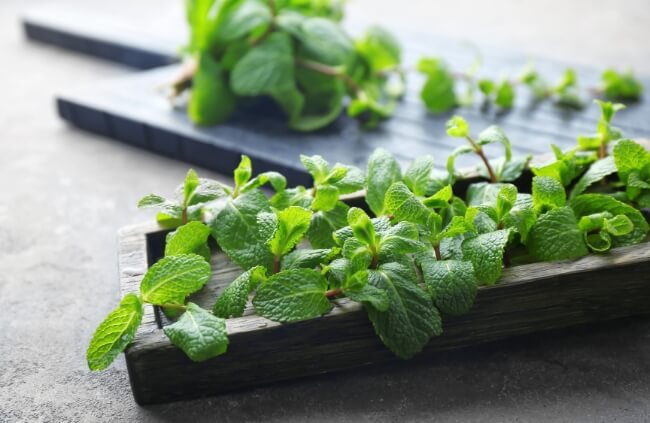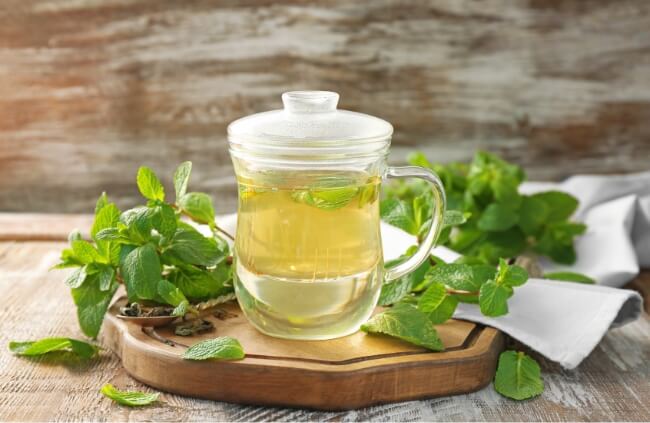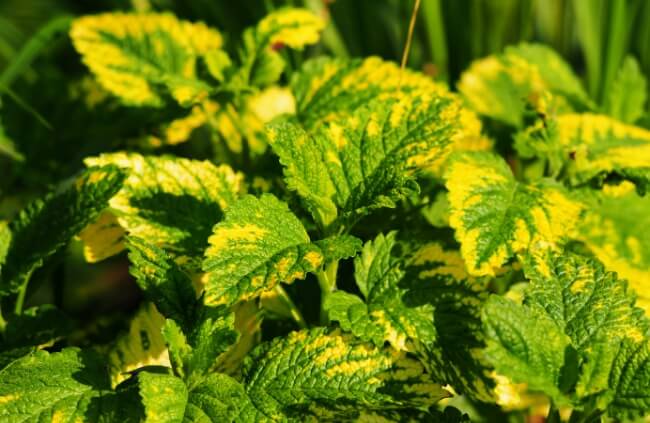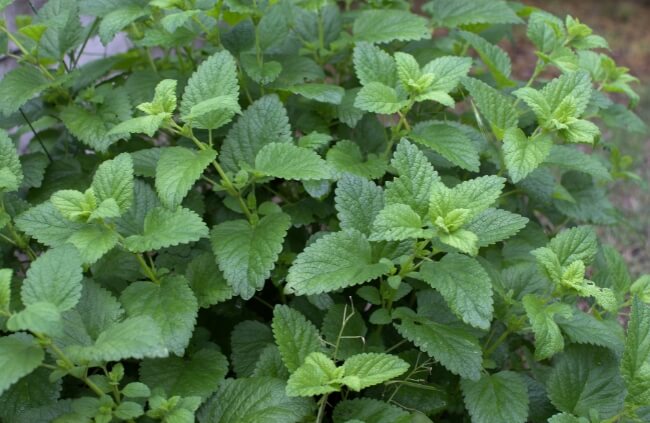Of all of lemon balm’s uses, its ability to aid a relaxing and deep sleep is the one I go to most often. Hops, lavender, valerian, and all sorts of other herbal remedies are traditional sleep aids, but a bag of dried lemon balm placed into a pillow does wonders for a good night’s sleep, and it’s incredibly easy to grow.
Growing your own lemon balm is pretty much impossible to get wrong, to the point it can even become a problem plant around the garden. As long as you keep it under control, and offer it soil that doesn’t get completely waterlogged, lemon balm will grow. But read on to learn how to get your lemon balm to truly thrive.
More...

Family: | Lamiaceae |
|---|---|
Genus: | Melissa |
Species: | M. officinalis |
Common Name: | Lemon Balm |
Origin: | Europe |
Location: | Outdoor |
Type: | Herbaceous perennial |
Growth: | 1 m tall |
Sun requirements: | Full sun or part shade |
Foliage Colour: | Green |
Flower Colour: | White |
Flowering: | Summer |
Edible Parts: | Leaves, stems and flowers |
Maintenance level: | Very low |
Poisonous for pets: | Non-toxic to cats and dogs |
What is Lemon Balm?
Lemon balm is the common name for Melissa officinalis (Melissa meaning ‘honey bee’ and officinalis meaning ‘of the workshop’). Its Latin name is inspired by its use in traditional herbal medicines, and as a digestive soother, but also how incredibly attractive it is to honey bees and other pollinators thanks to nectar-packed flowers. Its common name is from its calming properties and distinctively sweet lemon scent.
This herbaceous perennial is a member of the mint family and will grow with equal vigour in most gardens (helping it make our list of herbs to plant once, pick forever). Its roots spread and produce new plants on solons, and its subtle flowers are incredibly attractive to pollinators, making it a very successful self-seeder.

Best Uses for Lemon Balm
Lemon balm is an incredibly effective sleep aid, whether taken as a tea, used as dried herbs for scent or hung as fresh cuttings above your bed. It is also a traditional remedy for upset stomachs and digestive discomfort, acting in a similar way to mint tea to settle stomach acid.
In terms of its use as a garden plant, it makes a great and manageable mid-layer plant, that doesn’t steal the show but provides a verdant backdrop for border-front annual planting, and an effective ground cover around the base of shrubs or taller flowering perennials.
Melissa officinalis Natural Habitat
Lemon balm has a wide native range but is generally seen as a Mediterranean plant, despite a native range spread from central Europe to central Asia.
Today, lemon balm has naturalised on nearly every continent and grows wild everywhere from woodlands to open grassland where it has no particular preference for conditions.
8 Lemon Balm Varieties to Try for Yourself
As well as standard lemon balm, there are a few great garden varieties out there, specifically cultivated for unique aroma or leaf forms. The eight below are distinct enough to recognise as separate varieties, but most others are often challenging to tell apart.
1. Melissa officinalis ‘Citronella’
Citronella, while bearing no resemblance to the plant that provides the classic scent, does smell distinctly like citronella, and its flavour is particularly powerful. Other than scent, it grows in much the same way as other lemon balms, with near identical foliage and flowers.
2. Melissa officinalis ‘Limoncello’
Lemon balm has a kind of sickly sweet fragrance, unlike other members of the mint family. Those sugars don’t typically translate to taste - which is more often than not simply a zesty addition to infusions - but with limoncello it does.
The scent and zingy flavour are both reminiscent of that sugar tipple, limoncello.
3. Melissa officinalis ‘Quedlinburger’
Quedlinburger, or Quedlinburger Niederliegende to give it its full name, is the most valuable lemon balm variety for commercial cultivation with a notably higher essential oil content than any other cultivar.
Its leaves are also more rigid than most, providing something slightly different when it comes to garden design as well as just its culinary uses.
4. Melissa officinalis ‘Altissima’
With all the same medicinal uses as lemon balm, this cultivar, also known as Lime Balm, has a uniquely fragrant flavour. As you might expect, it's closer to lime than lemon, and leans on the sweetness of lemon balm’s aroma as the base for its perfume.
It makes a beautiful tea, and the yellow foliage is a great way to soften arrangements of pots and container planters.

5. Melissa officinalis ‘Aurea’
Similar to other variegated forms, but with less uniformity to its variegation, and distinctly green growth tips, M. officinalis ‘Aurea’ is a wonderful kitchen windowsill herb, but perfectly well suited to outdoor growing too.
The more you pinch back and harvest this beautiful lemon balm, the better its shape will be, and the long it will hold those stunning colours.
6. Melissa officinalis ‘Mandarina’
This pale-leaved form of lemon balm, Melissa officinalis ‘Mandarina’, has a pungently aromatic orange perfume, both from its flowers and leaves, with a sweet, nectar-rich edible flower that is well worth trying.
7. Melissa officinalis ‘Variegata’
Variegated lemon balm is a wonderful choice if you know your garden suffers from mint rust. The variegated leaves hide damage and make even the worst affected specimens look happy and healthy.
And it's not just a practical plant either, the fragrant foliage can be used just like any other lemon balm, and the softening effect it has on beds and borders is like nothing else.
8. Melissa officinalis ‘All Gold’
One of the most common cultivars is Lemon Balm ‘All Gold’. this popular garden variety is prized for its vibrant golden-green leaves that establish into neatly domed clumps of lemon balm and will grow on any well-drained soil.
How to Grow Lemon Balm in Australia

Confinement is the most important consideration for growing lemon balm. It is a vigorous plant that spreads through roots and seed distribution, so deadheading after flowering and restricting it to raised beds and pots are common practices even for growing lemon balm on a commercial scale.
In gardens, it’s a little simpler, especially if you’re happy to be free with your planting and let beds and borders develop naturally.
Growing Lemon Balm Outdoors
Growing lemon balm outdoors couldn’t be simpler. It will grow in clay, sand, loam, and only chalky or granite soils with ease. It is tough against competition, so shouldn’t be planted with other herbaceous perennials as it will usually outcompete them (though I find fennel to pair well, as it will routinely shoot up through lemon balms, offering a gorgeous frothy contrast to the dense green foliage below).
Soil & Drainage
Lemon balm prefers good drainage but will grow in most conditions, provided its roots don’t sit submerged for more than a couple of days at a time. Best practice would suggest giving lemon balm a well-drained, sunny spot, but we used to live in a garden that flooded for at least a week every summer at the back, and our lemon balm didn’t mind it one bit.
Light Requirements
Lemon balm will always do best in full sun. Not just in terms of the plant’s health, but in terms of the potency of its aroma, and usefulness as a herbal remedy. Direct sun encourages more concentrated essential oils in mints and lemon balms, so it’s always worth finding a good spot, even if it’s just to maximise that fragrance around the garden.
How to Grow Lemon Balm Indoors
Lemon balm can be grown as a kitchen herb, on a bright windowsill with regular watering. Simply sow a few lemon balm seeds, or plant a small rooted section, into good compost in a 10-15 cm pot.

How to Propagate Lemon Balm
If you’re worried about propagating lemon balm, don’t be. It’s one of the easiest plants in the world to propagate, whether it is from seed, division, or cuttings – and there are several ways to do each.
Lemon balm is one of those plants that looks best at its most natural, dotted around the garden and left to its own devices. But, gardening isn’t the pursuit of nature, it’s the pursuit of the control of nature.
Bringing non-native plants into our gardens offers a way to add to our natural spaces, but it also requires maintenance, so that they don’t take over. Dividing, cutting, deadheading and generally controlling lemon balm will offer a much more natural-looking balance in your garden.
To help keep on top of it, here are some handy tips for propagating lemon balm yourself.
Propagating Lemon Balm from Seeds
Lemon balm can be grown from seed indoors at any time of year, or sown directly into the garden any time from late spring to mid-autumn.
To sow lemon balm in seed trays, mix plenty of grit or perlite through half-decent compost (used potting compost from last year will do just fine) and keep it moist but not wet. It should germinate in a bright spot within two weeks, and be ready for potting on after a month.
To sow lemon balm directly where you want it to grow, clear a small area of soil of any weeds, and any top plants that will shade it in early summer. Water it well initially, and then just give it a light sprinkle every few days after germination.
Once germinated, it can cope with competition and will develop well in its first summer, reaching near maturity in its second.
Lemon Balm Propagation from Cuttings
Lemon balm will nearly always root from cuttings, regardless of what part of the plant you take the cutting material from. The easiest way is to cut a 10-15 cm section of semi-mature growth (this year’s growth, taken in late summer is ideal) and pop the cut end immediately into a glass of clean water.
Change the water every couple of days, and within a week you should see roots emerging. Once the roots are 2-3 inches long, you can gently plant it into a gritty potting mix in small 10 cm pots.
The same method can be done in spring with new growth, but I find these take better directly in a tray of sandy compost. Simply cut a handful of 10 cm-long shoots from lemon balm in spring and inert those 5 cm apart in a tray of sandy compost. They will root and be ready to plant out by early summer.
Propagating Lemon Balm from Division
Lemon balm grows very similarly to mint, with underground stolons that spread close to the surface. These roots develop new plants along their length, which can be divided at any stage.
New shoots emerging near a mature lemon balm can be dug out of the ground with a trowel (try to keep the soil and roots around the base intact), and planted immediately into other parts of the garden.
If your lemon balm is getting carried away, and a clump has become too vigorous, simply drive your garden fork into the ground between two stems, and dig one half up. Backfill the hole to stop water pooling, and replant the divided section anywhere it will fit.
How to Care for Lemon Balm
Lemon balm doesn’t need any day-to-day care, but there are ways to look after them if they are underperforming, or if you take regular cuttings, to boost growth and produce repeat flushes of flowers.

Mulching & Feeding Lemon Balm
Feeding lemon balm is straightforward and, honestly, not 100% necessary. But, just like mint, if you can add nitrogen back into the soil, and reasonably healthy levels of ammonia, it will generally produce better fragrance.
You can do this with a typical homemade compost, or by sprinkling small amounts of slow-release organic fertilisers like chicken manure around the base of the plant in spring.
Water Requirements
Lemon balm is technically a drought-tolerant plant, in that it will recover from drought. However, if you are experiencing intense heat waves or prolonged droughts, your lemon balm can look incredibly withered and dry.
If this happens, water well and leave it until the soil dries out again before watering. In mid-summer, a weekly drink can help sustain lemon balm right through the most challenging weather – and if you forget, just water it. It will recover.
Pruning Lemon Balm
Lemon balm can reach 1 m tall and will look stunning when it gets there. However, mature, naturalised lemon balms are not as long-lived as their pruned counterparts.
For the best display and freshest foliage, cut your lemon balm back by about half every spring. This will encourage a beautiful bounty of fresh foliage in the summer that follows.
Repotting Lemon Balm
Lemon balm grows well in pots. Its ability to recover from underwatering is impressive, so it lends itself well to containers. However, its roots are vigorous, and will grow in tight rings around the outer walls of any container it’s in.
That means that annual repotting is a must. Either plant the entire plant into a bigger pot or split it in half and replant the original plant back into its old pot. The new plants can be planted elsewhere, given to a friend, or left to dry out before adding to the compost.
Using Lemon Balm Seedlings as a Companion Plant
Lemon balm will self-seed anywhere you let it. I love that, and we use that to our advantage in the veggie patch, where this relatively easy-going plant can grow as a pest deterrent alongside crops.
Not only does lemon balm attract bees to pollinate your crops, but it actively deters rodents and rabbits, who may have dinner plans for your veggies.
Pull out any self-seeded lemon balms on an annual basis. They will replace themselves, and this limits them from becoming large mature plants that out-compete your crops.
Deadheading Lemon Balm
If you prefer to keep your garden neat and tidy, regular deadheading of lemon balm is a must. The seed heads and faded flower spikes add little in the way of winter interest, so simply cut the whole flower stem back to its base. This will encourage new flowers through summer, and prevent pollinated flowers from forming seeds.
Common Lemon Balm Pests and Diseases
Lemon balm is fairly pest and disease-resistant. Like most widespread herbs, over-watering and waterlogged conditions can cause fungal problems, but generally that is only when paired with pest damage, or damage from dirty tools during harvests.
Lemon balm is a natural pest deterrent, making it a valuable asset in the garden (and one you can simply rub on yourself to deter midges. However, aphids and some species of spider mites love it, particularly in healthy but well-drained conditions.
There’s not much you can do about it, other than blasting them off with a hose. Watering well once a week will reduce spider mite numbers (they breed in dry soil).
Mint rust affects lemon balm in the same way as it affects mint. If you notice brown patches and soggy foliage on any plant in the mint family, cut it off, burn it, or throw it in the trash. It’s a fungal infection and can harm any plant in that family, causing leaf drop, and the death of entire plants.
Thankfully it’s quite simple to control, but it is common because it is promoted by regular cutting, which is unavoidable on these fragrant herbs that need deadheading and are regularly harvested.
Lemon Balm Frequently Asked Questions

What is lemon balm good for?
Lemon balm is a good herbal remedy for sleep disturbance and restlessness. Its scent alone can help with calm nights, and reduce stress-related anxiety. Like mint, lemon balm is also good as a tea, offering relief from indigestion.
Is it ok to take lemon balm every day?
Like everything in life, lemon balm is best in moderation, but it is safe to take lemon balm every day. A lemon balm tea is a safe herbal drink whose only reported side effect is a slightly increased appetite when taken too often.
Can you eat lemon balm leaves raw?
It is completely safe to eat lemon balm leaves raw. Finely chopped lemon balm leaves can be added to salads to add texture and freshness, and small young leaves can be sprinkled whole onto ice creams and desserts as a deliciously zingy garnish.
When is the best time to drink lemon balm tea?
One cup of lemon balm tea about half an hour before bed will aid relaxation and help to reduce signs of anxiety. Drinking lemon balm tea during the day is great to ease general stresses, but also just because it tastes good, and I’d quite happily drink it for that reason alone.
Is lemon balm frost hardy?
Lemon balm will die back over winter and regrow each spring. They are hardy even through deep frosts, so are safe to grow in any part of Australia as a low-maintenance, outdoor herb.
What should you not grow with lemon balm?
Annual plants will nearly always be outcompeted with lemon balm, so it's best not to grow things like basil, cosmos, or anything that you need to start from seed alongside lemon balm.
Is lemon balm safe for dogs?
Lemon balm is safe for dogs and cats, and they generally hate the flavour. Any citrus-scented plants are useful for gardens for that reason – they are very, very, rarely damaged by pets.
Is lemon balm a mosquito repellent?
Lemon balm is a useful mosquito repellent, similar to lemongrass, though I find lemon grass to be more effective. Planting lemon balm around the garden will add a layer of defence against mosquitoes, and offers a readily available natural repellent you can rub directly onto your skin.
Wrapping Up Our Lemon Balm Guide
There are definitely downsides to growing lemon balm, all of which stem from its incredible ability to self-propagate. However, I firmly believe that it’s worth growing in spite of them. Lemon balm offers traditional herbal remedies, pest protection, and a gorgeous scent, and I’ve yet to find a garden that hasn’t been improved by its addition.
While it can be intrusive, it’s not strictly invasive, and minimal; annual maintenance will keep any lemon balm in check. Just follow this guide and you’ll be able to grow (and control) your lemon balm with ease.
Published on November 1, 2023 by Maisie Blevins
Last Updated on May 9, 2024




